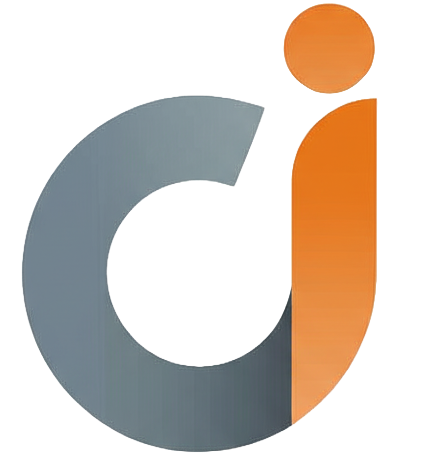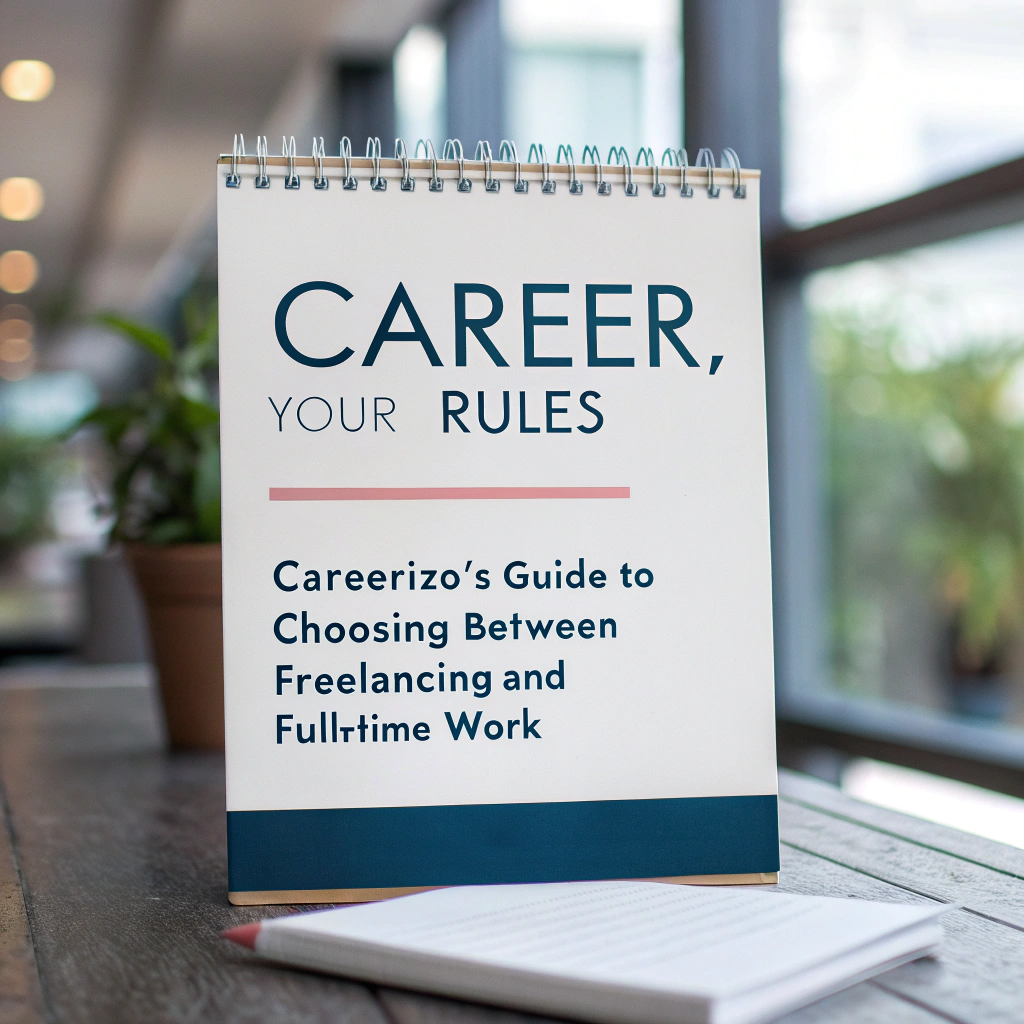Your Career, Your Rules Careerizo’s Guide to Choosing Between Freelancing and Full-Time Work
Think about it: It’s 6 AM, and while your past work friends are still in bed, hitting snooze again and again, you are in your PJs, drinking coffee, laptop ready, set to start the day how YOU want. Nice thought, yes? But look, freelancing isn’t all bright sun and free time, just as full, time jobs aren’t the dark trap some say they are.

The work world has changed a lot. Now, we live in a time where you don’t have to stick to the old plan for your job. You have many choices, and really, that’s both cool and scary.
The Great Career Crossroads Where Dreams Meet Reality
Let’s keep it real. Are you a new grad looking at too many job posts? Or an old hand who wants a new path? You might be at this choice point. Do you jump into freelancing, where you run the show? Or stay with a normal full, time job that gives a steady income and sure pay?
It’s like picking between a wild roller coaster and an easy train trip. Both take you places, yet the feel? So not the same.
Freelancing The Wild West of Career Choices
The Sweet Taste of Freedom
Three years back, when I jumped into freelancing, it felt like I got the keys to my own place. No more asking if I can take a lunch break. No more acting busy when I felt tired at 3 PM.

Here’s what freelancing really offers
Ultimate flexibility: Work from a beach in Bali or your local coffee shop • Income potential – Sky’s the limit when you’re not capped by a salary • Diverse projects – Say goodbye to monotonous tasks •
Work life integration: Blend your personal and professional life seamlessly • Skill development – Constantly learning and adapting to different client needs
But let’s not sugarcoat it. Freelancing can feel like you’re constantly walking on a tightrope without a safety net.
The Not So Pretty Side of Going Solo
Think of that pal who left their day job to do solo graphic design work. The one who shared shots of working at cool coffee spots on Instagram? What they didn’t show you were the late, night scares about money or the emails saying “no” that hurt a lot.

The reality check includes
Inconsistent income Feast or famine becomes your new normal No benefits Health insurance, paid vacation? You’re on your own Isolation Working alone can get lonely fast Business management You’re not just doing the work, you’re running a business Client dependency One difficult client can make or break your month
By the way, I once had a client who disappeared for two months without paying a $3,000 invoice. That’s when I learned the hard way about having emergency funds and ironclad contracts.
Full Time Employment The Traditional Path with Modern Twists
The Comfort of Structure
There’s something undeniably comforting about knowing exactly when your paycheck will hit your bank account. Full-time employment isn’t just about the money though – it’s about belonging to something bigger than yourself.

The perks that keep people coming back
Steady income Budget with confidence Comprehensive benefits Health insurance, retirement plans, paid time off Career progression Clear pathways for advancement Team collaboration Built-in support system and mentorship Resource access Tools, training, and technologies you might not afford solo Work-life boundaries When you clock out, you’re done
When the Golden Handcuffs Feel Too Tight
But truly? Sometimes that safe feel costs more than cash. It’s about your freedom, your art, and at times, your mind.
The challenges you might face
Limited flexibility Office hours, vacation approvals, location constraints Income ceiling Your earning potential is often predetermined Office politics Navigating workplace dynamics can be exhausting Routine monotony Same tasks, same meetings, same everything External control Someone else calls the shots about your work
I remember chatting with Sarah, a marketing manager at a Fortune 500 company. She told me, “I make good money, but I feel like I’m living someone else’s life Monday through Friday.”
Decoding Your Career DNA: Which Path Suits Your Personality?
Here’s where it gets interesting. Choosing between freelancing and full-time work isn’t just about money or lifestyle it’s about understanding who you are at your core.
You Might Be a True Freelancer If:
- You love change and do not like to get bored.
- You’re fine with not knowing and taking risks.
- You can work alone well and know how to plan your time.
- You like to handle different tasks (selling, counting money, running projects).
- You prefer to work on your own than have a safe job.
- By nature, you love to set up new things.

You Might Prefer Full-Time Work If:
- You appreciate structure and routine
- You prefer collaborative environments
- You want clear career advancement paths
- You value comprehensive benefits and job security
- You like focusing on your expertise without business distractions
- You prefer work-life separation
Let’s dive into something personal here. My brother and I are complete opposites. He’s been with the same tech company for eight years, loves his team, and recently bought a house thanks to his stable income. Meanwhile, I’m over here juggling five different projects, haven’t taken a proper vacation in two years, but I’ve never been happier professionally.
The Hybrid Revolution Why You Don’t Have to Choose Just One
Plot twist: What if I told you that you don’t have to pick just one path forever? The modern career landscape is more fluid than ever before.
Consider these emerging options
Contract to hire positions Test drive full time roles Part-time freelancing Keep your day job while building a client base Remote full-time work Enjoy employment benefits with location flexibility Consulting roles Freelance-style projects with corporate clients Gig economy platforms Structured freelancing with built-in support
Making the Decision A Practical Framework
Choosing your career path isn’t a decision you should make over a weekend Netflix binge. It requires honest self reflection and strategic thinking.
Step 1: Assess Your Current Situation
Money Truth Time
- How much cash do you need each month to pay for your bills?
- Do you have half a year to a full year of saved cash for sudden needs?
- Do you take care of others?
- How much risk can you handle?
Step 2: Define Your Non Negotiables
Create two lists:
- What you absolutely need from your career
- What you’re willing to sacrifice
For example, if morning flexibility is non-negotiable because you’re caring for elderly parents, freelancing might be your answer. If comprehensive health insurance is crucial due to medical conditions, full-time employment could be the way to go.
Step 3: Test the Waters
Don’t just jump wade in gradually.
For potential freelancers:
1.Start with weekend projects
2.Build a portfolio while employed
3.Network within your industry
4.Calculate your target hourly rate
For those considering full-time work:
1.Explore contract positions first
2.Attend industry networking events
3.Update your LinkedIn profile
4.Practice interviewing skills
Industry Insights What the Data Really Shows
According to recent studies, the freelance economy is projected to grow by 15% annually through 2027. But here’s what the statistics don’t tell you – success rates vary dramatically based on preparation and industry.

Top freelance fields:
- Online ads and handling social media
- Making websites and apps
- Writing and crafting content
- Art design and creating logos
- Giving advice and making business plans
Stable full-time opportunities:
- Healthcare and medical services
- Education and training
- Government positions
- Technology and engineering
- Finance and accounting
Honestly, the best career choice is the one that aligns with your personal values, financial needs, and life goals. There’s no universal right answer.
Transitioning Successfully: Your Action Plan
Making the Leap to Freelancing
Month 1-3: Foundation Building
- Research your market rates
- Create a professional website and portfolio
- Set up business banking and accounting systems
- Draft standard contracts and proposals
Month 4-6: Client Acquisition
- Leverage your existing network
- Join freelance platforms strategically
- Develop a content marketing strategy
- Track your metrics and adjust pricing
Transitioning to Full-Time Work
Getting Ready:
- Add clear wins to your CV.
- Make your LinkedIn look good.
- Look up key firms and job kinds.
- Go over common job talk points.
Application Phase:
- Apply strategically to 3-5 positions weekly
- Follow up professionally
- Prepare for different interview formats
- Negotiate offers confidently
FAQ: Your Burning Career Questions Answered
Q: Before going freelancing, how much should I have saved?
A: Financial advisors advise 612 months of living expenditures plus extra money for company startup expenses (website, tools, marketing). As a safety net, I would advise starting with at least $10,000–15,000.
Q: Am freelancing permissible while maintaining my regular employment?
A: Yes, but first examine your employment agreement. Many companies have clauses for noncompete. Start little with assignments that won’t clash with your current job’s hours or customer base if permitted.
Q: What does a normal pay gap look like between freelancing and full, time jobs?
A: It changes a lot depending on the work field and how much you know. Some freelancers make 2, 3 times what they did before, but some find it hard to earn as much at first. The main thing is to get a strong group of clients over time.
Q: How do I know if I’m ready to make the switch?
A: You’re ready when you have financial cushion, a clear business plan, some potential clients lined up, and most importantly, the mental resilience to handle uncertainty.
Q: Is it tough to find a full, time job after doing freelance work?
A: Not really. Many bosses like the range of skills and self, start that freelancers have. Show your freelance work as your own small business and point out clear wins.
Real Talk My Personal Career Evolution
I want to tell you something open and honest. Five years back, I was the guy who would check job sites every day, send out a lot of resumes, and face a lot of “no’s”. I felt stuck in a loop of trying for jobs that didn’t make me happy, just to get money to cover my needs.
The turning point came when I realized I was trying to fit into someone else’s definition of career success. I started freelance writing as a side hustle, not because I had some grand entrepreneurial vision, but because I needed extra money for my student loans.
Fast forward to today: I’ve worked with over 50 clients, traveled to 12 countries while working, and built an income that fluctuates but averages more than my previous full-time salary. But here’s what I didn’t expect the personal growth that came with it.
That said, freelancing isn’t for everyone, and that’s perfectly okay. My best friend Sarah chose the full-time route and just got promoted to senior marketing director at her dream company. She has amazing benefits, loves her team, and sleeps soundly knowing her income is predictable.
The point? There’s no wrong choice, only the wrong fit for your current life situation.
Your Next Move: Taking Action Today
Here’s the deal with job choices, they don’t last forever. You can shift, change, and grow. The biggest mistake is to get stuck in endless thinking.
Start with these immediate actions:
- Do a honest financial assessment Know your numbers
- Talk to people Interview both freelancers and full-time employees in your field
- Start small Test your preferred path without burning bridges
- Set a timeline Give yourself a deadline to make a decision
- Trust your gut Sometimes your intuition knows what your brain is still debating
Remember, your career should serve your life, not the other way around. Whether you choose the stability of full-time work or the adventure of freelancing, make sure it aligns with your values, supports your lifestyle goals, and challenges you to grow.
Ready to Take Control of Your Career Path?
Your career journey is uniquely yours. Don’t let anyone else’s definition of success overshadow what fulfillment means to you.
Conclusion
Your career is one of the most personal journeys you’ll ever take, and no single path fits everyone. Choosing between freelancing and full-time work depends on your goals, lifestyle, and the kind of freedom or stability you value most. According to Wikipedia, freelancing has surged in popularity worldwide, offering flexibility and independence to millions of professionals. On the other hand, Careerizo points out that traditional full-time roles still provide stability, consistent income, and long-term career development opportunities.
The real key lies in self-awareness—understanding what motivates you and what environment brings out your best work. Some thrive in structured settings, while others shine when given the freedom to set their own pace. Both freelancing and full-time jobs can lead to success, but only you can decide which aligns with your personal ambitions and values.
At the end of the day, remember: your career, your rules. Whether you choose to work independently or within an organization, what matters most is that your decision helps you grow, stay fulfilled, and build the future you envision.
Take the first step today:
- Join our community of career changers for ongoing support and resources
- Download our free “Career Decision Matrix” to clarify your priorities
- Schedule a consultation to discuss your specific situation with career experts
What will you do next? The chance to make your work life what you want is all yours now. Are you on team freelance or team full, time? The key thing is that you make a clear choice, not just let things happen to you.

